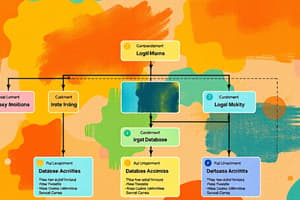Podcast
Questions and Answers
Which of the following BEST describes the primary function of structure models in the context of data modeling?
Which of the following BEST describes the primary function of structure models in the context of data modeling?
- Defining the data and information structures inherent in a business process. (correct)
- Managing user authentication and authorization protocols.
- Describing the user interface elements of a database application.
- Illustrating the flow of data between different software modules.
What is the purpose of data models in the design and implementation of databases?
What is the purpose of data models in the design and implementation of databases?
- To provide graphic representations of the conceptual contents of databases and facilitate communication between users and designers. (correct)
- To define the physical storage locations of data on storage devices.
- To optimize the performance of database queries and data retrieval.
- To establish security protocols for database access.
In a logical database structure model, what does cardinality primarily describe?
In a logical database structure model, what does cardinality primarily describe?
- How many users can access the database simultaneously.
- The number of attributes associated with an entity.
- The amount of storage space allocated for each data record.
- How many instances of one entity can be related to another. (correct)
Class diagrams, utilizing UML notation, are used to describe which aspect of a database system?
Class diagrams, utilizing UML notation, are used to describe which aspect of a database system?
What BEST describes a 'class' in the context of data modeling and UML?
What BEST describes a 'class' in the context of data modeling and UML?
How are classes typically implemented in a relational database?
How are classes typically implemented in a relational database?
In a UML class diagram, what information is typically displayed in the middle compartment of a class?
In a UML class diagram, what information is typically displayed in the middle compartment of a class?
What is the role of 'associations' in UML class diagrams?
What is the role of 'associations' in UML class diagrams?
In UML, how is an association between two classes visually represented?
In UML, how is an association between two classes visually represented?
What do association names typically represent in data models?
What do association names typically represent in data models?
What does the term 'multiplicity' describe in the context of class associations?
What does the term 'multiplicity' describe in the context of class associations?
How are multiplicities represented for a class in a UML diagram?
How are multiplicities represented for a class in a UML diagram?
What is the primary purpose of defining 'attributes' in a class?
What is the primary purpose of defining 'attributes' in a class?
What crucial role does a 'primary key' (PK) serve in a database table?
What crucial role does a 'primary key' (PK) serve in a database table?
When selecting an appropriate primary key, which criterion is MOST important?
When selecting an appropriate primary key, which criterion is MOST important?
What is the primary purpose of a 'foreign key' (FK) in a relational database?
What is the primary purpose of a 'foreign key' (FK) in a relational database?
What is the main purpose of structure models?
What is the main purpose of structure models?
What does organizational governance involve?
What does organizational governance involve?
What is a key characteristic of a good primary key?
What is a key characteristic of a good primary key?
What is the effect of a Generalization relationship
What is the effect of a Generalization relationship
Flashcards
Structure Models
Structure Models
Describe data and information structures inherent in a business process. They help in planning, documenting, and implementing databases.
Purpose of Structure Models
Purpose of Structure Models
To create a blueprint for the development of a relational database to support the collection, aggression, and communication of process information.
Data models
Data models
Graphic representations of database contents that support communication between users and designers.
Class Diagrams
Class Diagrams
Signup and view all the flashcards
Class
Class
Signup and view all the flashcards
Attributes
Attributes
Signup and view all the flashcards
Associations
Associations
Signup and view all the flashcards
Association Names
Association Names
Signup and view all the flashcards
Multiplicities
Multiplicities
Signup and view all the flashcards
Attributes in Classes
Attributes in Classes
Signup and view all the flashcards
Primary Key (PK)
Primary Key (PK)
Signup and view all the flashcards
Foreign Key (FK)
Foreign Key (FK)
Signup and view all the flashcards
Relationship
Relationship
Signup and view all the flashcards
Generalization Relationship
Generalization Relationship
Signup and view all the flashcards
Aggregation relationship
Aggregation relationship
Signup and view all the flashcards
Composition Relationship
Composition Relationship
Signup and view all the flashcards
Constraints
Constraints
Signup and view all the flashcards
Business Rule
Business Rule
Signup and view all the flashcards
Obligatory rule
Obligatory rule
Signup and view all the flashcards
Prohibited rule
Prohibited rule
Signup and view all the flashcards
Study Notes
Structure Models
- They describe data and information structures in business processes
- They are tools for planning, documenting, discussing, and implementing databases
- Primary goal is to create a blueprint for relational database development
- Supports process information collection, aggression, and communication
Data Models
- They are graphic representations of database conceptual contents
- They facilitate communication between users and designers of the database
- A logical database structure model describes entities, relationships, cardinalities, attributes and characteristics
Class Diagrams
- They are structure models using UML notation
- They describe the logical structure of a database system
Classes
- They are separately identifiable collections of things (objects)
- Organizations collect and store information about these objects
- They represent organization resources like trucks, buildings, cash, and investments
- They also represent people (customers, employees) and events (sales, purchases) and conceptual structures like budgets
Class Implementation
- Classes are implemented as tables in relational databases
- Instances of objects are represented as rows in these tables
- Each class is represented by a rectangle composed of three compartments
- Top Compartment: Displays the name of the class
- Middle Compartment: Shows the attributes (data elements) shared by all instances
- Bottom Compartment: Describes the operations each instance can perform
- Attribute and operation compartments are optional
Entities
- In UML notation, entities (people, things, events) are modeled as classes
Associations
- Associations depict relationships between two classes
- For example customers participate in sales
- Associations are drawn as lines connecting two classes
- Associations can be named to clarify the business purpose of the association
Association Names
- They are verbs or phrases that describe the relationship between instances of classes
Multiplicities
- They describe the minimum and maximum number of times instances in one class can be associated with another
- Represented as a pair of numbers on the opposite side of the association for a class
- Binary associations will have two sets of multiplicities
- Minimum values can be 0 (optional) or 1 (mandatory)
- Maximum values can be 1 or many (*)
Attributes
- They are data elements describing class instances
- Attribute specifications include data type, default value, constraints, and descriptive information
Primary Key (PK)
- It is an attribute or combination of attributes that uniquely identifies each instance in a class or table row
- It can be modeled within the attribute list on a UML diagram
- It serves as a unique identifier for each instance in the class
Primary Key Criteria
- It must uniquely identify each class instance, avoiding duplicable values like names
- It cannot be null (blank) under any circumstances
- Not using attributes that are potentially unavailable for any instance of the class is important
- It should not change over time
- Should be controlled by the organization assigning it to ensure uniqueness
- Sequential values make it easier to recognize gaps in data
- Shorter key values are preferred for ease of entry, indexing, and retrieval
Foreign Key (FK)
- It is an attribute or combination of attributes that link tables
- It links to the primary key of another table to support a defined association
Relationship
- It is the business purpose for the association between two classes or database tables
Generalization Relationship
- It is a UML symbol grouping things sharing characteristics
- It reduces redundancy by modeling shared characteristics only once
Aggregation Relationship
- It is a UML notation representing relationships between classes often considered together
- This is used when a sports league is made up of teams
Composition Relationship
- It is a UML notation representing relationships similar to aggregation
- In this relationship one class cannot exist without the other
- For example, a book and its chapters
Mapping UML to Relational Database Schema
- Map classes to tables
- Map class attributes to table fields
- Assign primary keys
- Map associations to foreign keys, placing them toward the "many" side
- The primary key of the "1" side becomes a foreign key on the "*" side
- Minimum multiplicities are determined by the timing of entries in associated tables
- If an entry in one table must match an entry in the other, the minimum is 1; otherwise, it is 0
- Create new tables to implement many-to-many relationships
- A many-to-many relationship occurs when maximum multiplicity is * on both ends
- Implement relationships among tables
Decision Model and Notation
- Involves four iterative steps:
- Identifying decisions
- Describing and documenting their impact on business objectives
- Specifying decision requirements
- Decomposing and refining requirements
- Determining where business rules apply and where new rules are needed
Operational Decision Categories
- Eligibility/Approval: Determining eligibility for a product or service
- Validation: Assessing the validity of a claim for processing
- Calculation: Determining the correct discount for a customer
- Risk: Assessing the risk of relying on a supplier's delivery date
- Fraud: Assessing the likelihood of fraudulent claims
- Opportunity: Identifying the best available option
- Assignment: Assigning an issue to the appropriate party
- Targeting: Determining the appropriate response
Constraints
- They are optional or mandatory guidance about process performance
Business Rules
- They support decision-making, standardize processes, and constrain actions
- They are succinct statements of constraints, guiding behavior in specific situations
- They establish multiplicities in class models and criteria for branching in activity models
- Obligatory rules state what should occur
- Prohibited rules state what should not occur
- Allowed rules state what is allowed under certain conditions.
Semantics of Business Vocabulary
- It sets standards for stating business rules using natural language
Enforcement Levels
- Strict Enforcement: Violations are not authorized
- Pre-Override: Violations allowed if authorized in advance
- Post-Override: Violations allowed if authorized after the violation
Decision Tables
- Combine multiple business rules for different circumstances requiring a decision
- Consist of a name, inputs, outputs, and rules
Organizational Governance
- Involves business planning, execution, monitoring, and adapting
- During planning, leaders establish objectives, identify risks, create processes, and implement controls to mitigate risks
Studying That Suits You
Use AI to generate personalized quizzes and flashcards to suit your learning preferences.




